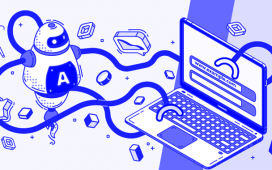
In at least 10 schools, Inpixon has installed radio frequency scanners that pull data from phone signals like Bluetooth and Wi-Fi to keep track of students.
Angela Lang/CNET
Teachers often lament that phones can be a distraction in classrooms. Some governments have even banned phones outright in schools. But a few school administrations see phones in schools as a benefit because they can help keep track of students more efficiently.
At least 10 schools across the US have installed radio frequency scanners, which pick up on the Wi-Fi and Bluetooth signals from students’ phones and track them with accuracy down to about one meter (just over three feet), said Nadir Ali, CEO of indoor data tracking company Inpixon.
His company has been in talks with more interested school districts, and a few schools in the Middle East are also considering the product, Ali said. He wouldn’t disclose the names of any schools working with the company.
Schools are interested in Inpixon because they believe the technology will keep students safe, Ali said. His company has proposed that the technology can help prevent school shootings by picking up signals from devices belonging to blacklisted people when they’re nearby.
But this type of dragnet surveillance raises privacy concerns, with every device being tracked and followed on a constant basis, not just the ones related to potential threats. Parents may consider buying a tracker for their own child. But it’s another thing if the tracking is being implemented across the board at schools, requiring parents to opt out if they don’t want their kids tracked.
And there are questions about its effectiveness, with even those who support more surveillance admitting that it won’t stop school shootings.
Inpixon already offers indoor positioning analytics in malls, offices and prisons, and now it wants to bring its phone tracking technology to schools. It even has a specialized tracking tool for children who aren’t old enough to have their own phones.
“Some of these schools may have younger kids, so they may not be carrying phones, so there’s an application where there’s a wristband or a tag they can use in lieu of a phone,” Ali said. “The schools that are looking at wristbands usually have elementary-level kids on campus.”

Marketing material for Inpixon shows that it would use wristbands for younger students, which would also track their biometrics.
Inpixon
Track and field
The use of indoor positioning analytics is not a new concept — many retail stores like Target and the resurrected Toys “R” Us locate shoppers in stores and gather data on them, providing analytics on how popular certain aisles and items are, for example.
Retailers and other businesses are increasingly gathering data by tracking the Bluetooth and Wi-Fi signals from phones. Even when you aren’t interacting with your handset, it’s sending probing signals out to connect to other devices when your Bluetooth and Wi-Fi are turned on.
Those signals come with a media access control, or MAC address, that’s unique to your device. Companies like Inpixon use that data to track people and their movements, even if the subjects aren’t aware this is happening.
It’s so widespread that researchers at Carnegie Mellon University developed an app to help detect when these scanners are being used.
“Our research has shown that many people are unaware of these deployments and would like to have a notification mechanism, which is precisely one of the issues our infrastructure addresses,” said professor Norman Sadeh, a CyLab faculty member at the university’s Institute for Software Research.
Now, that hidden tracking infrastructure looks to follow people in school hallways, adding another layer of surveillance in educational spaces. This comes on top of other forms of tracking, with schools increasingly adopting facial recognition and social media scavenging services to keep an eye on students.
Colleges have also started requiring students to download tracking apps to mark attendance and monitor their mental health, The Washington Post reported last December.
Privacy advocates warn that as this technology finds its way into schools, children could suffer developmental issues from the constant surveillance.
“Over time, surveillance of students makes them feel like everything they do is going into a permanent record held by people or entities they don’t know about,” said Amelia Vance, director of youth and education privacy at the Future of Privacy Forum. “It makes them less likely to step outside the box or bring up an idea in class.”
Still, surveillance technology is getting installed in schools as administrators believe that safety concerns outweigh privacy issues.
The threat of a school shooting is a real worry for administrators who have turned to technology to keep students safe despite there being no evidence that surveillance actually saves lives. In January, facial recognition providers admitted that their technology doesn’t prevent school shootings, even as school districts still spend millions on the surveillance tools.
Inpixon falls into that same category — Ali noted that the company has no studies to show that its technology will actually prevent school shootings or make students any safer, though it’s part of the company’s pitch.
What Inpixon doesn’t do is use the device to track attendance or monitor student behavior, according to Ali. But the data collected could provide those insights.
“This is really about school safety and the balance between safety and privacy,” Ali said. “That’s a balance the community has to make.”

Inpixon said it uses radio frequency scanners to pick up on people’s locations in buildings. Here, the demo is staged around a school and multiple classrooms.
Inpixon
On the air
Inpixon’s radio frequency scanners pick up Bluetooth, Wi-Fi and cellular signals. And they aren’t just picking up signals from phones — the scanners also detect signals from smartwatches, tablets, headphones and printers, too.
Promotional material for Inpixon in schools recommends putting at least one scanner in every classroom.
That data is logged and displayed on a dashboard for Inpixon’s customers, who can see where people are, how long they’re there for and a history of their movements throughout the day.
Inpixon argues the data has safety applications. Knowing where people are in emergencies would help first responders know where to go, Ali said. It could also log people who aren’t supposed to be there, he added.
In schools, for example, administrators could log every student’s devices, and if an unknown or blacklisted MAC address is discovered, it would be registered as a security threat. That could be useful if a potential school shooter were on campus, Ali said.

Promotional material for Inpixon told schools that they should have at least one scanner in each classroom.
Inpixon
But that method lends itself to potential false positives, as students can always get a new phone or bring in a device that’s not registered. When that happens, Ali suggests sending a security guard to further investigate.
“You send security, you find out where that device is, and you identify it and it gets registered,” Ali said, suggesting that a security guard would have to confront a student any time a new device is brought to school.
There is reportedly a long history of school safety officers abusing students, with teens being shot with stun guns at least 120 times since 2011, according to the Huffington Post. The majority of students reportedly abused by school security officers are minorities.
“The idea that I would send a black or brown kid to school with a new phone, and some security guard would check to see where they’re supposed to be, it sounds really dangerous,” said Chris Gilliard, a professor of English at Macomb Community College who studies institutional tech policy and privacy.
Anonymized doesn’t mean anonymous
Inpixon maintains that the data it collects is anonymized, since it’s capturing device information and not personal details like your name.
But in a demo for Inpixon’s security capabilities, the company showed that device data could be easily combined with security cameras to tie people to their phones.
The clip showed a man stealing a bag and then using logs of phone data collected throughout the day to match his identity with video footage. Inpixon calls this “RF Video Connector,” and Ali noted that this technique could also be used in schools.
While Ali maintained that the data collected from schools is anonymized, much of what it collects from devices are persistent identifiers and can be easily engineered to figure out who a person is.
“We know from numerous studies and examples today that it’s a trivial matter to deanonymize things,” Gilliard said.
And the anonymity claims apply only to the general public; if students log onto their school Wi-Fi, Inpixon’s scanners can identify them, Ali said.
Schools have long used their building Wi-Fi to identify students, Vance said. In Maryland, four teens had been caught committing a hate crime on school property after their phones connected to the building’s Wi-Fi automatically. “Anything that is collecting device identifiers, even if it’s been told to ignore that device, is still sending a ping somewhere,” the FPF’s Vance said. “Claiming that this would be anonymous is not accurate.”
Then there are the wristbands Inpixon offers to students too young to own a phone, which boast a higher degree of tracking, including monitoring students’ steps, calories and heart rate and whether they are present in class.
Inpixon doesn’t have any guidelines or restrictions for how schools can use the data, and the degree of tracking raises a red flag if you’re concerned about privacy.
“This is stuff that we do to animals in the wild and pets,” said Liz O’Sullivan, technology director of the Surveillance Technology Oversight Project. “It’s inhumane.”
Privacy vs. safety
Despite the privacy concerns, Ali believes Inpixon’s technology makes schools safer, although he didn’t provide any data to back that claim.
“A lot of these companies, particularly in ed tech, make wild, unsubstantiated claims about how useful they are with very little metrics attached and usually no independent research that will affirm that,” Gilliard said.
Ali said the company was inspired to bring its data tracking from malls and jails to schools because of school shootings and believes that it’s something parents want to keep their children safe.
“You have to make sure you’re working with the community to get proper consent, and within the boundaries of privacy laws,” Ali said. “Parents and their community can make decisions on security versus privacy trade-offs.”

The radio frequency scanners are used in malls, prisons and office buildings.
Inpixon
When weighing the two, providing safety often takes priority for parents and school administrators, but experts warn that there are clear, long-term dangers with taking privacy away from students.
“We can choose to live in a surveillance state, and perhaps save some lives and be safe down the line, but it’s important to consider what we lose as a society,” Vance said.
Researchers have already found that people change their behavior when they think they’re being watched. A 2013 study found that people were less likely to litter on a university campus when they had seen signs with eyes watching.
Though that may seem like a good sign, the study could not determine if it was because people felt better under surveillance or felt more pressure to conform because they were being watched.
For teens and children in school, the pressure to fit in is already high, and a surveillance state could amplify that, experts warned. With scanners tracking people’s location, it’d be able to tell how long a student spent time in a bathroom, or at the guidance counselor’s office or at the nurse’s office, for example.
Technology is often sold to entire school districts, not just a single school. That means the data collected from kids in kindergarten could follow them all the way until they go to college.
“What’s most concerning is that there’s nothing stopping them from creating a ledger of kids from a very early age,” O’Sullivan said. “If you’re living in a society where there’s no right to be forgotten, you’re going to pay for that in the future.”






